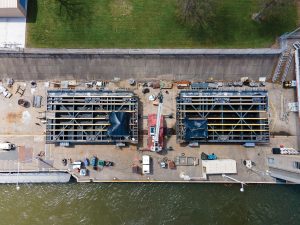Crews are more than two months into the projected three-month repair of upstream miter gates in the main chamber at New Cumberland Locks and Dam, Ohio River Mile 54.3.
The Great Lakes and Ohio River Division’s medium-capacity fleet is repairing cracks to the two gates’ steel girders, webbing and existing welds, said Caleb Schultz, the Pittsburgh Engineer District’s project engineer for the New Cumberland Miter Gate Repairs Project. The gates are more than 20 years old, he said, and they have experienced a lot of wear and tear.
The work involves removing the gates, cutting out the bent and cracked steel and welding in new pieces. Each gate leaf is 35 feet tall, 61 feet wide, and weighs 235,000 pounds.

Additionally, crews are replacing embedded anchorages that date back to the 1950s.
“While we had this anchorage exposed, it made sense to repair and replace the anchorage as well,” Schultz said.
That work involves sawing out large chunks of concrete using a diamond wire saw. Engineers provided inspection and repair procedures.
The fleet deployed its dive team to remove and replace old pintle balls, which give gates a pivot point to open and close. The rubber J seals at the base of the gates are also being replaced to prevent dry rot.
The main chamber closed to navigation February 28. Work is scheduled to be complete in late May or early June. The repair project was scheduled three years ago to accommodate the schedule of the medium-capacity fleet, Schultz said. A challenge to the work involved long lead times in procuring replacement parts, which can take one to two years to be manufactured and delivered.
Extreme precision is also required to set the repaired gates back in place in exactly the same position to ensure they seal properly and to prevent leaks, he said. To place the gates back into the chamber, a crane operator has to set the pintle bushing directly on top of the pintle ball. Crews have coordinated with the Pittsburgh Engineer District’s survey team to complete that work.
While the 1,200-foot by 110-foot main chamber is closed, vessel traffic continues to move through the 600- by 110-foot auxiliary chamber. Miter gates in that chamber were replaced in late 2022.
Schultz said there has not been a need for a queue so far as traffic continues to move. He credits weekly calls with industry stakeholders and notifications about brief auxiliary chamber closures to provide access to the worksite as far in advance as possible as being key to ensuring safety and efficiency for all involved.

The repairs to the gates became necessary, in part, because of a barge allision that compromised their structural integrity, Schultz said. He said performing the repairs now will help to maintain their reliability for years to come.
“The main goal is to keep these chambers operational for our inland navigation,” Schultz said, adding that proactive repairs help to prevent or minimize future emergency closures.
According to the Corps, more than 180 million tons of bulk commodities travel the Ohio River through its system of navigational locks each year. Typical commodities moved in the region include coal, petroleum products, chemicals, aggregates like sand and gravel, grain and other industrial materials.
Featured photo caption: A welder for the Medium Capacity Fleet works to repair damages on a miter gate April 15 at New Cumberland Locks and Dam. The fleet, which is part of the Huntington Engineer District, arrived on site to begin work at the end of February and is expected to complete the repairs by the end of May.




